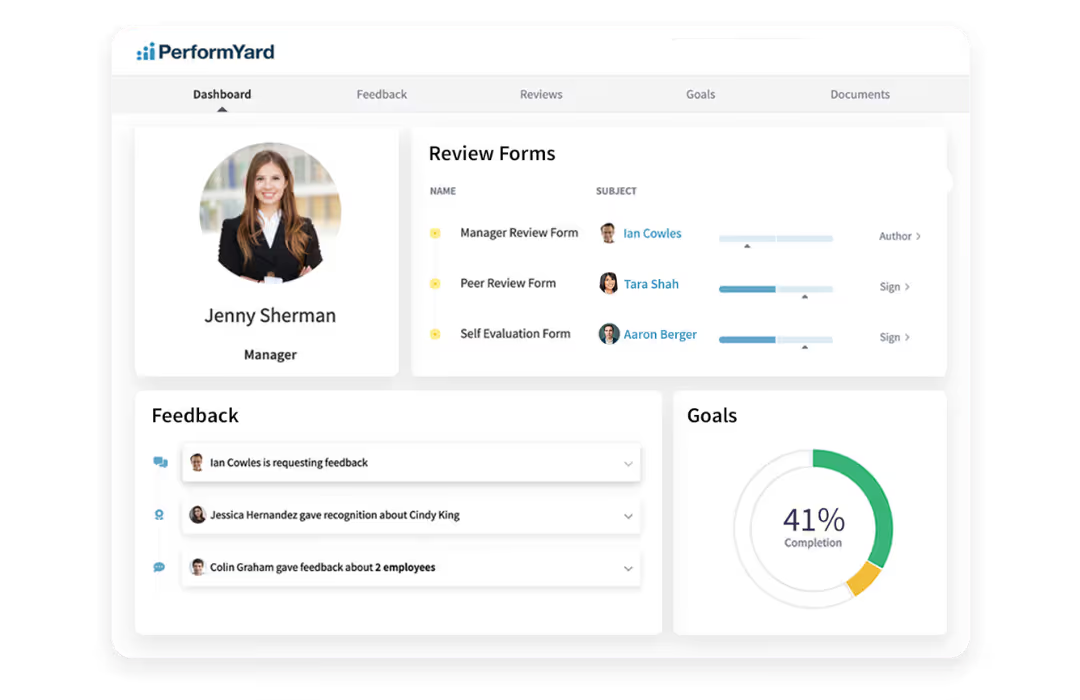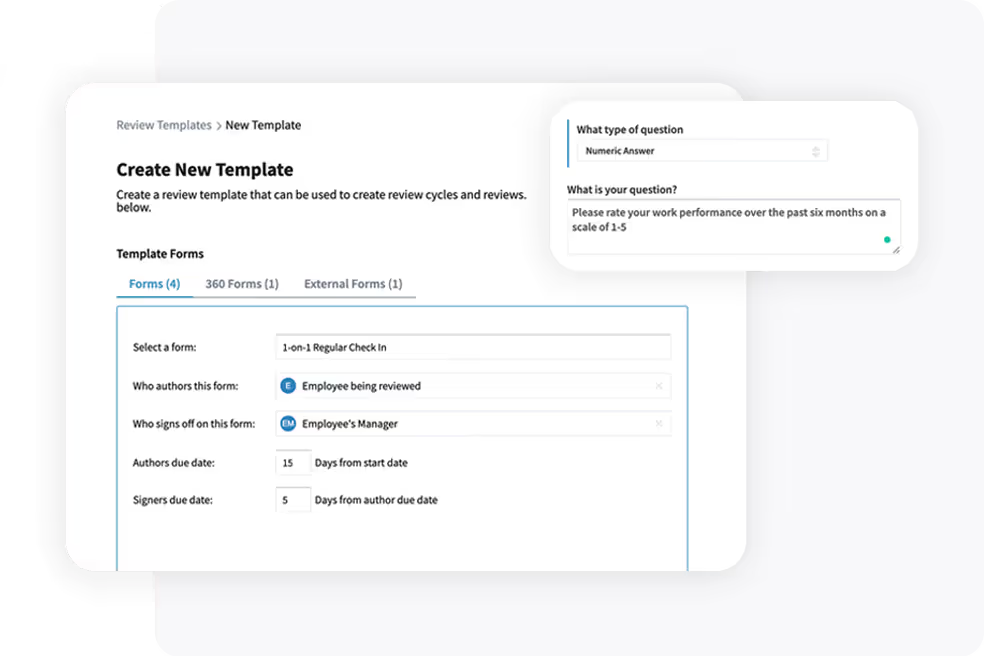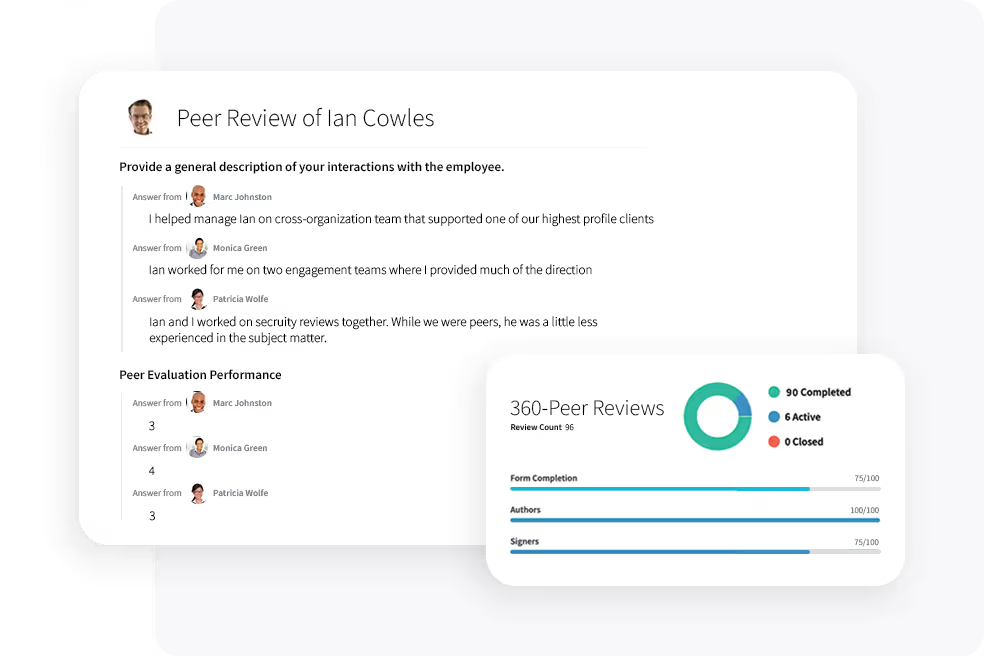What Is Performance Management?
You might be doing performance management right now, but do you know why it matters? Understanding how it works and how to develop a process for your organization can be hard. It can feel even more overwhelming when starting from scratch.
It doesn’t have to be! Creating a custom performance management system isn’t as hard as it seems when you take things one step at a time.
This guide will tell you everything you need to know about performance management. We’ll also explore examples of performance management so you can build a firm foundation for your system.
Performance Management Explained
Performance management involves evaluating an employee's performance. The goal is to help employees perform to the best of their ability so organizational objectives can be achieved.
In the past, performance management systems were very judgemental. Managers held all the power over an employee’s standing, wages, and employment. Employees dreaded traditional performance management, and managers didn’t love it either.
Today, modern performance management is much more collaborative. It aims to support employees instead of simply judging them. Employees can participate in the process, and managers can take on a mentorship-type role. This drives learning and improvement that benefits employees and the organization they work for.
How do you define performance management?
How do you define performance management? Performance management is a comprehensive and strategic approach used by organizations to enhance employee performance, align employee goals with organizational objectives, and foster continuous development and productivity. Essentially, it encompasses the activities, tools, and protocols that managers use to ensure employees are meeting predefined standards and objectives efficiently and effectively.
Performance management is not merely about annual performance reviews; it is an ongoing process that involves setting expectations, continuous performance discussions, and feedback loops throughout the year. It integrates goal setting, performance appraisal, and development into a single, continuous strategy that aims to enhance organizational performance as well as employee satisfaction and growth. This approach ensures that employees are clear about what is expected from them and receive regular feedback on their performance relative to these expectations.
Furthermore, effective performance management involves recognizing and rewarding high performance, addressing underperformance through supportive interventions, and providing opportunities for professional growth and development. This holistic approach not only helps organizations achieve their strategic goals but also enhances employee engagement and retention by linking their career growth to business outcomes.
Why Is Performance Management Important?
Performance management benefits employees and the organization they work for.
For example:
- Reduced turnover: Give employees ample opportunities to talk to their managers. When those conversations result in growth opportunities, employees are happy to stay.
- Reduced liability risk: Use consistent criteria, transparency, and documentation to minimize legal liability.
- Better organizational alignment: Employee objectives should align with organizational objectives. This will help you evaluate how individuals contribute to the overall strategy. Assessments are more accurate, and individual improvements impact organizational goals.
What Is the Main Purpose of Performance Management?
What is the main purpose of performance management? Performance management serves as a systematic process designed to improve organizational effectiveness by enhancing the performance of individuals and teams. It aligns employee activities and outcomes with the organization's strategic goals, fostering a culture of continuous improvement and personal growth.
At its core, the main purpose of performance management is to ensure that employees' efforts support the achievement of broader business objectives. This is accomplished through various means, including setting clear performance expectations, providing regular and constructive feedback, identifying development opportunities, and rewarding achievements appropriately.
Performance management also plays a crucial role in motivating employees. By clearly defining the path to success and providing the tools and support to achieve it, employees are more likely to be engaged with their work and committed to the organization. Furthermore, effective performance management helps identify and mitigate performance issues, which can improve overall productivity and efficiency.
Ultimately, the main purpose of performance management is to create a high-performing workforce that can propel the organization toward its strategic goals while also supporting individual employee growth and satisfaction.
What Are the Best Performance Management Models and Approaches?
The performance management cycle will unfold in different ways. It depends on which model or approach you choose.
The question is, which approach is right for you?
First, it's important to match your performance management to your organization's needs. Don't just choose one that you like the best. It needs to closely match the goals you have for your business.
Once you know what it is, you can map out those needs and create a framework of strategies that serve your business and your employees.
Each of the five performance management options is tied to a purpose, which includes:
- Accountability
- Development
- Recognition
- Alignment
- Reinforcing values
Accountability
This option evaluates employees against a standard. It can work well when employees know exactly what is expected of them. It helps when there are systems in place that motivate employees to achieve those standards.
Development
Strategies like frequent one-on-ones, continuous feedback, and engagement surveys encourage employees to learn. This helps them contribute their best work to the organization they work for.
Recognition
By recognizing high performance, employees know without a shadow of a doubt whether they are achieving their goals. It can promote healthy competition and encourage employees to work harder to get that raise.
Alignment
Articulate goals and align them with the objectives you have for your business. This will help employees be motivated to achieve those goals.
Reinforcing values
Accountable employees who feel adequately recognized will benefit from a focus on values. A process that promotes self-reflection can build a culture that reflects the same values.
What Is HR’s Role in Performance Management?
For performance management to be effective, it has to take a big-picture view.
That's exactly what HR can provide.
HR can take a bird's-eye view of the process, helping managers, supervisors, and employees participate in a process they have created.
That means HR scaffolds the experience for everyone. They brainstorm questions, analyze data, and make tweaks to the performance management system. HR should do this after every round of reviews.
What Is Modern Performance Management?
Not too long ago, implementing performance management simply meant setting up an annual review.
That’s not the case anymore.
Modern performance management is all about creating a system customized to your organization’s needs. It includes building blocks like reviews, goals, and feedback tailored to your organization.
Modern performance management is about doing things because they’re right for you—not because they follow a particular trend.

What Is the Difference Between Performance Management and a Performance Management Process?
Performance management and the performance management process are not interchangeable.
Performance management encompasses the entire method. That includes different ideologies to approaches and goals.
The performance management process, on the other hand, is exclusively about the execution. It involves conducting the reviews and the communication between managers and employees. The process should also define expectations after the process is complete.
Performance Management Tools for Managers
Effective performance management is crucial for any organization aiming to enhance its productivity and employee satisfaction. Managers play a pivotal role in this process, and having the right tools can significantly streamline their efforts. Let's explore some essential performance management tools for managers that can help in overseeing and improving team performance.
Real-Time Performance Tracking
Access to real-time data is vital for managers. Tools that provide instant access to performance metrics allow managers to make informed decisions promptly. This could involve dashboards that display key performance indicators (KPIs) or real-time alerts notifying managers of significant achievements or areas needing immediate attention.
360-Degree Feedback Systems
A comprehensive view of employee performance is beneficial. 360-degree feedback tools involve collecting performance data from an employee's peers, subordinates, and supervisors, providing a holistic view of their work. This feedback is crucial for personal development plans and helps managers guide their teams more effectively.
Goal Setting and Tracking Applications
Clear and measurable goals drive employee performance. Managers can use goal-setting and tracking tools to set, monitor, and update team goals. These applications should allow for easy adjustment of objectives as business needs evolve and provide a platform for discussing progress during one-on-one meetings or performance reviews.
Employee Recognition Platforms
Recognizing and rewarding good performance is a key motivator. Platforms that facilitate employee recognition can help managers easily award 'kudos' or other rewards for notable achievements, fostering a positive work environment and encouraging continued excellence.
Automated Performance Review Tools
Streamlining the performance review process saves time and ensures consistency. Automated tools can schedule reviews, send reminders, compile review data, and store historical performance reviews for easy access during future evaluations. This helps maintain fairness in the performance management process and reduces administrative burden on managers.
Development and Learning Management Systems
Continuous improvement is foundational to employee retention and satisfaction. Development tools such as e-learning platforms can be integrated into performance management to link development directly with performance metrics, allowing managers to assign courses or materials based on individual or team performance gaps.
By integrating these performance management tools for managers, organizations can not only enhance efficiency but also improve the accuracy of performance assessments and the overall growth of their teams.
What Are the Steps in the Performance Management Process?
Working your way through a performance management system is made easier when you take things step-by-step.
The steps you need to take when tackling performance management include:
- Establish a timeline
- Choose your framework
- Decide who reviews whom
- Determine what you’re measuring
- Choose your questions
- Set your goals
- Collect your data
- Make sure all reviews are done in person
Establish a timeline
Decide how often you want to conduct reviews, and whether each of those reviews will carry the same weight. For example, you may conduct quarterly reviews, or you may have one main annual review with smaller monthly check-ins.
Choose your framework
Frameworks you can choose include OKRS, 360s, annual reviews, and balanced scorecards. You can also choose a combination of frameworks, or customize a framework just for your organization.
Decide who reviews whom
The most common choice is to have managers review their direct reports. You can also have employees review each other with a 360 review. Alternatively, you can implement an upward review where direct reports review their managers.

Determine what you're measuring
You'll want to decide if you're measuring qualitative or quantitative data. You should also make sure you have measurement systems, like a behavior observation scale (BOS), in place.
Choose your questions
You'll have to decide if questions will be standardized across all departments. Alternatively, have questions vary depending on roles. Let the framework you choose guide you to the right questions and don't be afraid to change or update questions at the end of every review cycle.
Set your goals
Employees should be allowed to set their own goals, but the objectives of performance management need to serve the entire organization. Managers and HR should follow the SMART system of setting goals to foster employee growth.
Collect your data
Take the time to collect the data from reviews. Then measure and compare that data with a performance software platform like PerformYard.
Make sure all reviews are done in person
Managers need to set aside time for a 1:1 with each of their direct reports to go over findings. It gives employees the chance to clarify issues, and both parties can plan for the next review cycle.
Why Is My Performance Management Failing?
It isn’t enough just to have a performance management plan in place. You can have one and discover it isn’t supporting your employees or your organization the way you expected.
So, the real question is: What is it about your performance management plan that is failing?
With many different types of performance management, looking into different methods is a good start, but chances are, something is lurking further under the surface that is causing your performance management approach to fail.
The four most common reasons why performance management is broken include:
- Annual appraisals are too heavy, which means they might be too long, one-sided, and complicated. Engage employees in the process and add additional feedback opportunities throughout the year to help combat this problem.
- Ratings can feel meaningless and inaccurate. Ratings should never be associated with personal identity characteristics, like an employee’s willingness to collaborate. They should also be followed up with development opportunities or recognition, according to the score received.
- Sometimes, feedback isn't tied to the company's mission. Feedback should only be given if, when it is implemented, it contributes to larger goals. It shouldn’t be tied to a manager’s preference for the way they like their direct reports to work, for example.
- In some cases, the review isn't valuable because it's full of fluff, or it simply isn't focused on the task at hand. The types of questions you ask can make all the difference. Ask clear, growth-focused questions and avoid detailed rehashings of a dispute between coworkers or an unpleasant client interaction.
What Are Some Performance Management Examples?
Indeed, you don’t want to copy anyone else’s performance management. You want to build a system from the ground up that suits your organization, but that doesn’t mean you can’t get some inspiration from others!
Looking at an example of performance management in action can help you clarify what you want—and what you don’t—from your performance management system.
A few companies with the best performance management practices include:
- Deloitte transitioned from annual objectives to a simple form with prompts that enable managers to conduct performance reviews more often.
- Adobe transitioned from spending 80,000 working hours on a labor-intensive review process to a system of check-ins with no specific or formal format so employees could meet with managers every quarter.
- Microsoft ditched their general, one-sided annual reviews and implemented a system with performance journals where employees can send and collect feedback when it's convenient for them.
- Google went from a format that focused on the feedback itself and now uses a nimble system that changes according to what works best for the employees who are receiving the feedback.
What are the 5 areas of performance management?
What are the 5 areas of performance management? Understanding these areas can significantly enhance the effectiveness of a company's overall strategy in managing employee performance. By focusing on these distinct areas, HR professionals can create a comprehensive framework to guide employee development and achieve organizational goals.
Planning
The planning stage is the foundation of performance management. Here, objectives and goals are clearly defined within the context of the company’s broader strategic plans. This often involves setting specific, measurable, achievable, relevant, and time-bound (SMART) goals with each employee to align their efforts with the organization’s objectives.
Monitoring
Routine monitoring is crucial to ensure that performance standards are being met and to identify any deviations from the set goals. Effective monitoring involves continuous communication and regular check-ins to review progress. This proactive approach allows for timely adjustments in strategies or performance expectations.
Developing
This area focuses on providing employees with the training, resources, and support they need to improve their skills and capabilities. Development activities such as coaching, workshops, seminars, and on-the-job training play a vital role in enhancing employee performance and preparing them for future roles.
Evaluating
Formal evaluation is an integral part of performance management, providing an opportunity to reflect on an employee’s achievements and areas for improvement. Evaluations should be fair, objective, and comprehensive, incorporating feedback from various sources to give a well-rounded view of performance.
Rewarding
Rewarding effectively acknowledges employees' efforts and achievements. This can be done through bonuses, raises, promotions, or non-monetary rewards such as recognition and career development opportunities. An effective reward system motivates employees and encourages high performance, aligning their achievements with the organization's success.
How Can I Improve My Performance Management?
You don’t have to have a failing performance management system to make improvements. Make changes here and there continuously. You’ll be able to keep up with the ever-changing demands in today’s fast-paced world.
Just a few strategies for effective performance management include:
- Setting clear expectations
- Providing quality feedback
- Reviewing goals often
- Giving and receiving feedback frequently
Making these kinds of improvements is important, but without some kind of way to automate the process, it will all be for nothing.
No matter how clear your expectations are, if you’re doing it with an Excel spreadsheet, things will fall through the cracks. Plus, you’ll waste countless hours that could be better used.
How Can I Streamline Performance Management?
So, how do you streamline performance management so you can optimize the process and save time?
Using software, like PerformYard, is the best way to create a performance management system that works for everyone.

That’s because PerformYard offers benefits that include:
- A single sign-on solution that puts every process on a single platform.
- A process that's easy to customize. HR should create different types of unique reviews, customize questions, manage timelines, and more.
- An intuitive system that stores reviews and information so employees and managers can find the exact information they need when they need it.
- The ability to analyze performance over time and by department, since information is cataloged on the same platform.
Want to see how PerformYard can streamline your performance management system?

.jpg)

.jpg)
